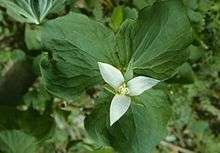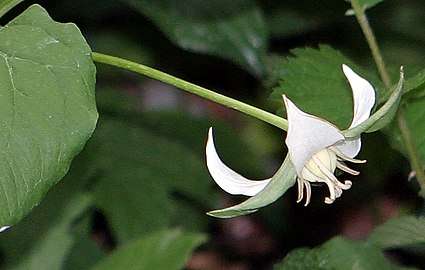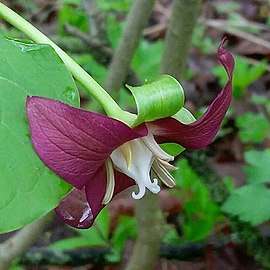Trillium flexipes
Trillium flexipes, known as the nodding wakerobin, bent trillium, or drooping trillium, is a species of flowering plant in the family Melanthiaceae.[3][4][5] It is found from Minnesota to Ohio, south to Tennessee, with isolated (and sometimes rare) populations in New York, Pennsylvania, Alabama, and other states.[6] It is an endangered species in Ontario[7] and possibly extirpated in North Carolina.[8]
| Trillium flexipes | |
|---|---|
 | |
| Scientific classification | |
| Kingdom: | Plantae |
| Clade: | Tracheophytes |
| Clade: | Angiosperms |
| Clade: | Monocots |
| Order: | Liliales |
| Family: | Melanthiaceae |
| Genus: | Trillium |
| Species: | T. flexipes |
| Binomial name | |
| Trillium flexipes Raf., 1840 | |
| Synonyms[2] | |
| |
Description
T. flexipes is a perennial herbaceous plant that spreads by means of underground rhizomes. In northern areas, the flower tends to hang below the leaves, while central and southern strains have a large erect flower.[9] The flower petals are normally white but can be reddish or maroon. The fruit is rosy red to purplish and fragrant of ripe fruit.[4]
 Typical flower with white flower petals
Typical flower with white flower petals Variant with red flower petals
Variant with red flower petals
T. flexipes is known to hybridize with other Trillium species. In particular, hybrids between T. flexipes and T. erectum can occur. Indeed, the red-petaled forms of T. flexipes tend to occur in regions where the ranges of both species coincide.[10] Hybridization is also suspected between T. flexipes and T. sulcatum.[11]
Bibliography
- Case, Frederick W.; Case, Roberta B. (1997). Trilliums. Portland, Oregon: Timber Press. ISBN 978-0-88192-374-2.CS1 maint: ref=harv (link)
- Patrick, Thomas S. (1984). "Trillium sulcatum (Liliaceae), a New Species of the Southern Appalachians". Brittonia. New York Botanical Garden. 36 (1): 26–36. doi:10.2307/2806287.CS1 maint: ref=harv (link)
References
- "Trillium flexipes". NatureServe Explorer. NatureServe. Retrieved May 3, 2008.
- "Trillium flexipes". World Checklist of Selected Plant Families (WCSP). Royal Botanic Gardens, Kew.
- "Trillium flexipes". Natural Resources Conservation Service PLANTS Database. USDA. Retrieved 15 December 2015.
- Case Jr., Frederick W. (2002). "Trillium flexipes". In Flora of North America Editorial Committee (ed.). Flora of North America North of Mexico (FNA). 26. New York and Oxford – via eFloras.org, Missouri Botanical Garden, St. Louis, MO & Harvard University Herbaria, Cambridge, MA.
- Stritch, Larry. "Nodding Wakerobin (Trillium flexipes)". United States Forest Service. Retrieved 7 October 2019.
- "Trillium flexipes". County-level distribution map from the North American Plant Atlas (NAPA). Biota of North America Program (BONAP). 2014.
- "Drooping trillium". Ontario Ministry of the Environment, Conservation and Parks. Retrieved 25 August 2019.
- "List of Rare Plant Species of North Carolina". North Carolina Natural Heritage Program. Retrieved 11 September 2019.
- Case & Case (1997), p. 103.
- Jalava, Jarmo V.; Ambrose, John D. (2012). "Recovery Strategy for the Drooping Trillium (Trillium flexipes) in Ontario". Ontario Recovery Strategy Series. Retrieved 23 January 2020.
- Patrick (1984), pp. 34-35.
External links
- Citizen science observations for Trillium flexipes at iNaturalist
- Biodiversity Information Serving Our Nation (BISON) occurrence data and maps for Trillium flexipes
